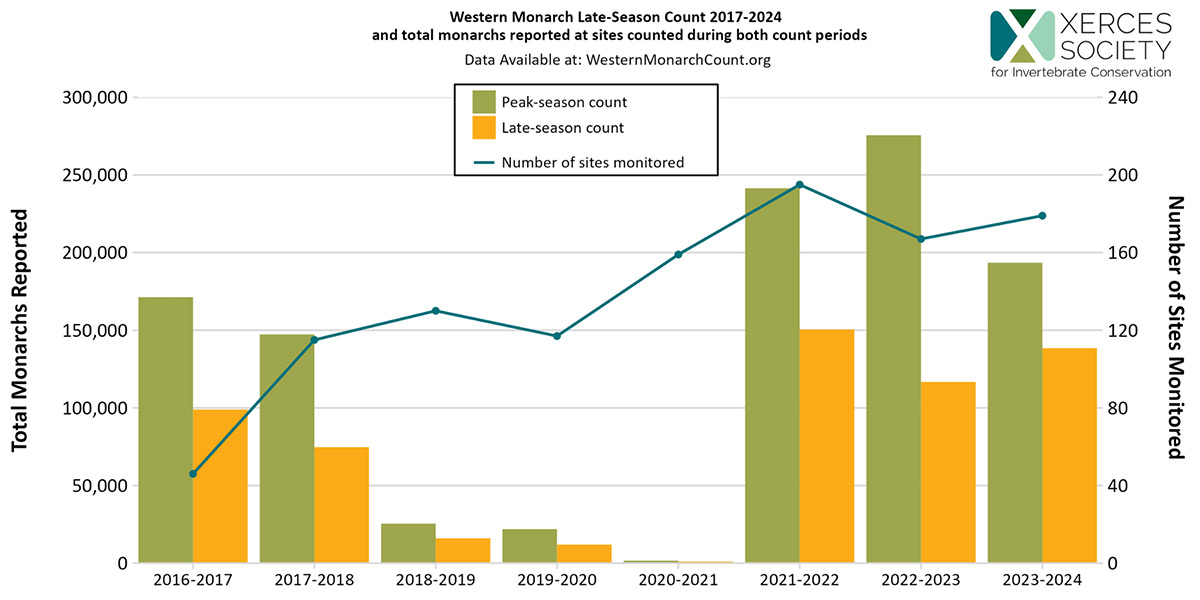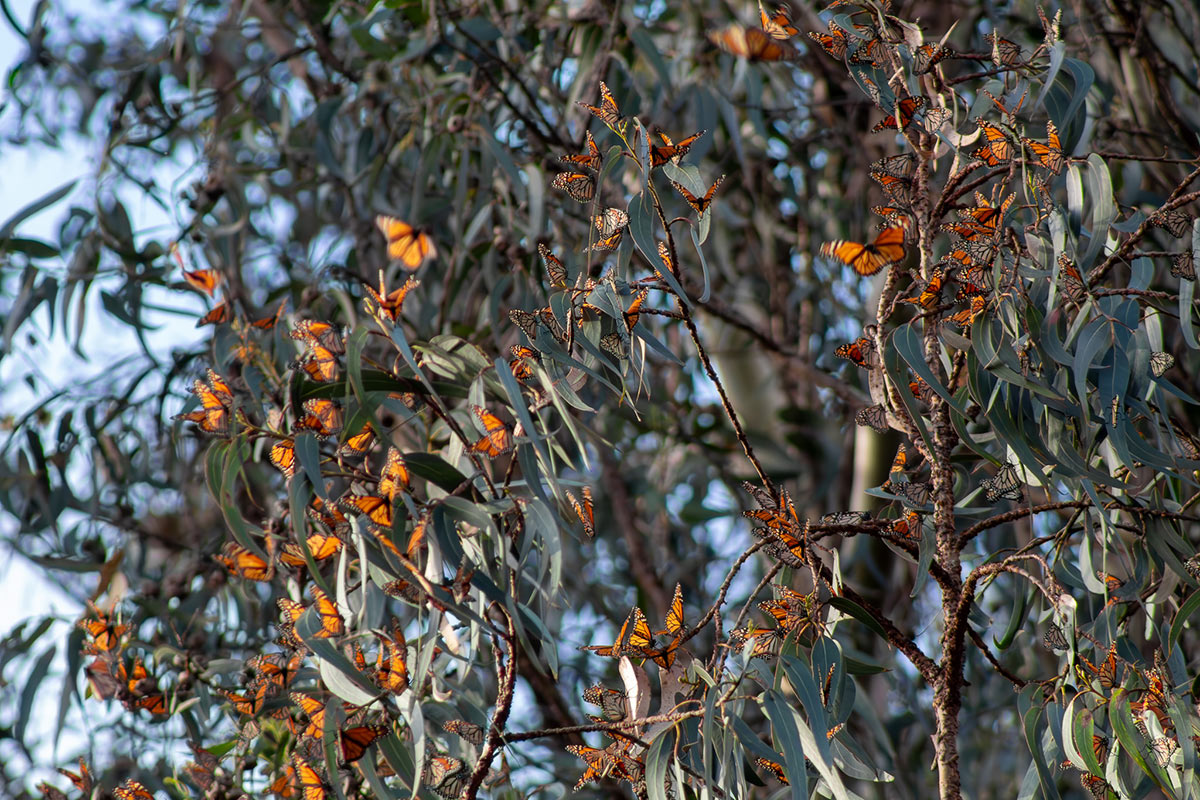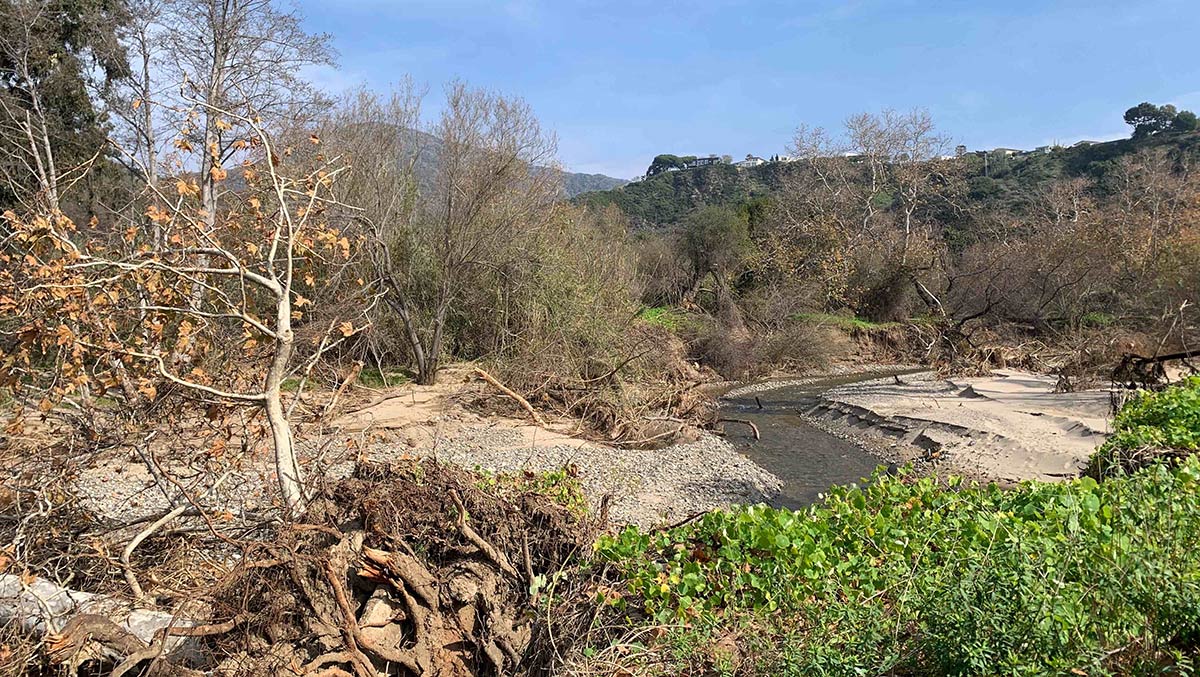The Xerces Society's latest findings from the Western Monarch Count indicate a 28% seasonal decrease in the overwintering western monarch population, a less dramatic drop than is typically seen. This year’s decrease is approximately half of what we recorded in the 2022-2023 late-season count, when overwintering monarch numbers dropped by 58% after enduring back-to-back storms in late December and early January.
November represents the peak of overwintering monarch butterflies, and numbers begin to decrease from December onwards. This is due to mortality from a variety of causes, such as winter storms and predation, as well as butterflies departing from the overwintering sites. A smaller seasonal decrease may indicate less monarch mortality, fewer butterflies dispersing during the overwintering season, or a combination of the two.
The late-season count also provides an estimate of how many butterflies remain to begin the spring breeding population. This year, a little over 141,000 butterflies were counted across 200 overwintering sites; by comparison, last year’s late-season count was only about 117,000. This suggests the population heading into the spring is modestly larger than last year, despite a lower peak-season count.

Seasonal changes in monarch numbers offer clues to habitat quality
The seasonal decrease is based on data collected by the Xerces Society’s community scientist volunteers, partners, and staff at 179 overwintering sites surveyed during both the peak-season count (November 11 - December 3, 2023) and late-season count, also known as the New Year’s count (December 23 - January 7, 2024). Comparing findings from the two survey periods helps scientists track how the western monarch population changes throughout the overwintering season. All Western Monarch Count data is available online.
Some sites have monarchs throughout the entire overwintering season (approximately October - March), while others host butterflies for only a few weeks or months. These temporary or transitional sites may imply lower habitat quality, although monarch behavior and overwintering site selection are still being studied. Of the 179 sites monitored during both the peak-season and late-season count periods, monarch counts declined at 112 sites, increased at 27 sites, and remained unchanged at 40 sites. The largest increase occurred at Ellwood Main, Goleta; the count changed from 7,643 butterflies in early December to 16,200 butterflies in early January. Similar to the peak-season trend, the majority of overwintering butterflies were observed along the Central Coast of California.
Regular monitoring in fall and winter improves our understanding of how monarchs use overwintering sites and allows scientists to prioritize protections for the most beneficial sites. The data can also help scientists identify sites that would benefit from additional management and conservation measures.

Storms and tree cutting damaged monarch overwintering habitat
With climate change, habitat loss, and pesticides posing ongoing threats to the monarch butterfly, there's an urgent need for scaled-up conservation efforts and legal protection. Monitoring this season revealed damage to several overwintering sites in California, including Lower Topanga Canyon in Los Angeles, and Spring Canyon at Vandenberg Space Force Base in Santa Barbara County. Both sites experienced storm damage from atmospheric rivers and high winds, resulting in downed or damaged trees. Besides natural forces, multiple sites were damaged by tree cutting as overwintering sites continue to lack meaningful protection.

Spring is a great time to take action for monarch butterflies
If you live in California, check out our popular habitat kit program which provides free native plants, including milkweed and nectar species, to create or enhance monarch and pollinator habitat on working lands, public lands, tribal lands and private/non-working lands recovering from wildfires. This includes farms, ranches, tribal land, post-wildfire recovery areas, urban farms, community gardens, city parks, school gardens and other public areas. We encourage projects that will benefit historically underserved or underrepresented communities. We will be accepting project proposals for our 2024 kits through April 5.
Here are another five easy ways to help western monarchs this spring and summer:
- Plant native milkweed.
- Plant native nectar plants.
- Submit photo observations of monarchs (all life stages) and milkweeds to the Western Monarch Milkweed Mapper website or iNaturalist project.
- Reduce your reliance on pesticides and advocate for pollinator-friendly nursery plants.
- Advocate for the protection and restoration of California overwintering sites.
For more information on how to help these butterflies recover, see our Western Monarch Call to Action.
Acknowledgements
A huge thank you to the hundreds of dedicated volunteers and partners who collected data at overwintering sites. And, thank you to our western monarch conservation funders, who make this work possible: California Department of Fish and Wildlife, California State Parks Foundation, California Wildlife Conservation Board, Google.org, U.S. Forest Service International Programs, The Marion R. Weber Family Fund, Monarch Joint Venture, National Fish and Wildlife Foundation, San Diego Zoo Wildlife Alliance, The Taggart Saxon Schubert Fund, USDA Natural Resources Conservation Service, USDOI Bureau of Land Management, US Fish and Wildlife Service, and Xerces Society members.




